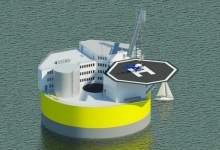

There are a number of factors that must be addressed when identifying a suitable site to locate a nuclear reactor. Population is a big one; put it too near a densely populated area and the public opposition will scupper development, but put it too far away from one and the output is not used most efficiently. Identifying easily reclaimable and flat land on which to build is also of vital importance. But most importantly,availability of water must be considered.

Discover B2B Marketing That Performs
Combine business intelligence and editorial excellence to reach engaged professionals across 36 leading media platforms.
As the operators of the nuclear power plant in Fukushima know only too well, the biggest challenge in nuclear safety is not responding to the initial incident, but enabling enough access to water to keep the radioactive materials cool. As a result of those and the many other issues that must be addressed in the siting process, the conventional approach is to build the reactor within relatively close proximity of a coast and draw on the plentiful supply of water provided by the sea. The issue, as Fukushima showed, is that such a convention leaves the plant at risk of disaster should a tsunami strike.
Charting a new course for nuclear
This conventional logic may change thanks to a team of scientists who have designed a new type of nuclear reactor that is able to draw on an ‘infinite heat sink’, or in common everyday language, the sea. The team, principally populated by researchers at MIT’s nuclear science and engineering department, has combined the concepts of small modular nuclear reactors and offshore oil rigs to create a floating nuclear reactor that is sited a few miles offshore.
The proposed model, which operates in the same manner as a land-based modular reactor, would be factory-manufactured and transported a few miles offshore to wherever it is needed.The team behind the project, the design for which is still at the conceptual stage, believes there could be particular demand for a commercialised model in markets such as Indonesia, Chile and Africa.
“We think that the combination of these two technologies gives some solid ground on which we can build a plant that has a good economic performance and an outstanding safety performance,” said Jacopo Buongiorno, associate professor of nuclear science and engineering at MIT. “It’s a plant that can be entirely constructed in a centralised shipyard and then towed to the site where it would be moored or anchored a few miles off the coast and link to the electric grid with a transmission line.”

US Tariffs are shifting - will you react or anticipate?
Don’t let policy changes catch you off guard. Stay proactive with real-time data and expert analysis.
By GlobalDataRussia is planning to deploy its first floating nuclear power plant in 2016, establishing a new way of powering remote Arctic communities.
Safe at sea
Putting nuclear reactors out to sea is not a new idea. The US first launched a floating reactor on the Panama Canal in 1968 and just last year Russia announced that after a number of years of research it will launch its first floating plant in 2016. The Russian model, which is being built at the BaltiyiskyZavod-Shipbuilding yard in St Petersburg, will feature two KLT-40S nuclear reactors installed on a barge that will be towed out to its chosen offshore location. The two reactors are reportedly capable of generating up to 70MW of electricity.
But the MIT team believes that its proposed design, which could generate anything from 50MW to 1,000MW of electricity, represents a safer way into the water. “Tsunamis and earthquakes are no longer a source of risk for the nuclear plant because essentially the ocean shields the seismic waves and the tsunami waves in relatively deep waters, say 100 metres deep, are not big so they don’t pose a hazard for the plant,” said Buongiorno.
“The ocean can be used as an infinite heat sink, so the decay heat which is generated by the nuclear fuel, even after the reactor has shut down, can be removed indefinitely and this is a major advantage with respect to current plants in which the ultimate heat sink is not assured necessarily for the very long term.”
While its design and ability to draw on the water around it provide clear safety benefits, it remains a reactor. It would still be prone to attack, and while the impact onshore of an accident would be minimised by venting into the sea, the impact on the sea life could be disastrous. With both Russia and now the US pushing ahead with the development, the days of nuclear power taking to the water look set to make a comeback. The MIT design offers clear benefits, and fewer risks, yet risks remain and must be addressed before the concept can be trialled.


.gif)



